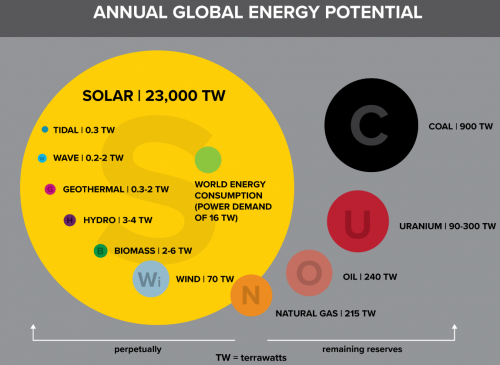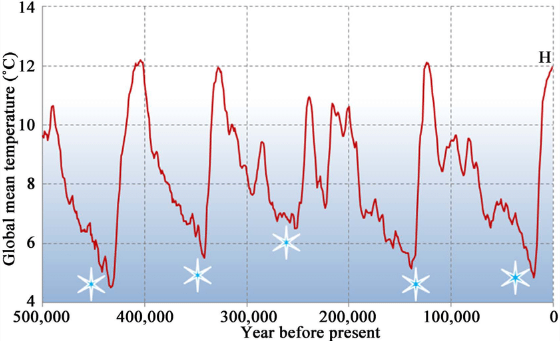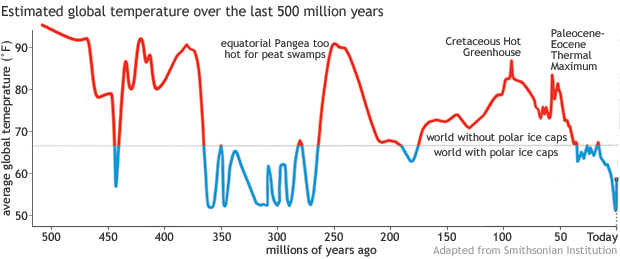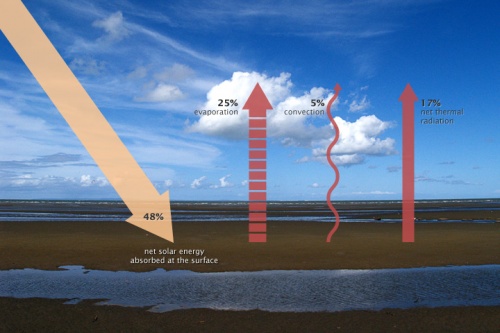500 Factor
Intro
The 500 factor is a factor calculated theoretically as the limit of possible increase of energy use by humans, without suffering from ecocide or changes in weather patterns. This energy would come from renewables, as fossil fuel or nuclear supply can meet this 500x factor need only for a short time (about 80 days).
This number is derived from the Earth's energy budget of incoming solar radiation, in which fossil fuel reserves are equivalent to only 8 days or so of solar energy income. Thus, fossil fuels do not count here.
To derive this number, consider that plants use about 1% of solar energy incoming - most is unused and left as heat. 30% of Earth's surface is plants [1]. Then this actually means that in order to not interfere with plant growth, humans could use any area not covered by plants. This could be up to 70% of the entire earth land area, in the big picture.
Derivation of 500 Factor
34% of solar energy that hits the surface of the earth is reradiated as heat. This energy is what can be used for PV - if we are not to interfere with weather. Weather interference would not exist because trapping this as PV energy still releases the embodied heat - but after extracting useful electricity in the process.
Therefore, the absolute max that we can use for PV is 1/3 of the 10000 Factor. We can tap only 15% or more as electricity with PV cells. Thus, we have about 1/20 (or about 1/3 of 1/6) of the 10000 factor - or about 500x more energy than we use today - if we account for maintaining current weather patterns.
Details
When we talk about the 10000 Factor in relation to the possibility of human prosperity, we must consider - first principles - that we can use only 10% as any process converts only about 10% of available energy into 'useful' form. For humans, 'useful form' could be, for example, electricity - where solar panels gather more than 10% of solar energy and convert it to electricity as an energy form useful for civilized life.
However, the starting number is 7000x - if we consider that about 30% goes to driving the weather.
If we start with 7000x - we thus have 700x roughly as potentially available, readily-usable energy to drive heating/cooling, industry, etc.
Under the assumption of complete Terraforming capacity in humans, we thus have a factor of 100x more energy than we use today if we consider a 7x buffer. This implies a 100x improvement in the standard of living. See Poverty Statistics. Equivalently, it would mean 100x more people that can be supported. As an intermediate, think of 10x more people, with 10x higher standards of living.
TLDR; for modern society is that currently, a Civilization Bypass is completely feasible from first principles, and is the current work of Open Source Ecology.
Significance
This amount of power - if used by humans - still allows for all natural processes such as weather phenomena and natural life - to exist without any first order effect.
This effectively means that the human population on earth could be unfathomably larger (500x more people), without negative effects on nature. In short: resources allow the population to grow much larger, of course if we use clean energy and clean chemistry.
Natural Systems
Weather is by far the largest current user of energy on Earth. About 25% of surface energy goes to rainmaking, and 5% to blowing wind (see #Energy Budget of the Earth below.
Of all life forms, Plants (not humans) are the largest users of energy. In particular - via solar energy capture with photosynthesis. Plants still use use only 1-2% of the incoming solar spectrum [2], and the earth's coverage with plants is about 30% [3]. Since only plants can use solar energy, and animals build ecosystems upon plant energy - the plant energy is the primary energy important to overall solar energy usage. Ie, animals do not use solar energy, outside of the heat - a component of weather. Bottom line - the amount of total energy required to sustain the ecosphere is under 1% of the total incoming radiation.
Both plants (under 1%) and Humans (0.01%) pale to the weather (30%) in terms of energy use. Fossil fuels don't even count here, as the entire store of fossil fuels is only a few days equivalent of solar energy (see 10000 Factor).
Source: [4]]
Every 100k years, we go through ice age and hot age - where mean temperature of the earth fluctuates up to 7C [5] and ice coverage of earth increases to 25% of land mass (8% of total).
Here is the history of temperature over 500 million years - showing that global averages of temp ran anywhere from 50 to 95 F [6] - that is - fluctuating over 25C over all time.
Energy Budget of the Earth
From NASA - [7]
17% of surface energy radiates back, not part of weather (rain and wind).
Don't mess with evaporation - or you will have drought.
Thus, at least 17% is available for PV, if we do not tap into any energy related to weather phenomena. This means that we could cover probably cover up to 17% of the earth with PV without changing weather. Nominally, this means that we can use about 1000x more energy than today, captured in the form of PV power without affecting climate. This is about 1/6 of the available 10000 Factor.
Practical Issues
- 3% of all surface area is urban. [8]
- 33% of surface area is desert [9]
- 17% available solar energy, for 1000x more power use - means tremendous amounts of area for power provision. However, say we only had to replace all the fossil fuels, or bring everyone to a modern standard of living (same energy use + Lifetime Design - then we would need only 0.1% of land area of the earth! This is completely doable! See Land Area Required for PV Energy.




